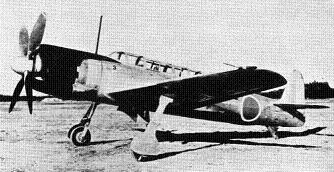![]() The Pacific War Online Encyclopedia
The Pacific War Online Encyclopedia
|
| Previous: C5M "Babs", Japanese Reconnaissance Aircraft | Table of Contents | Next: Cabanatuan |

U.S. Air Force. Via Francillon (1979)
Nakajima C6N1 Saiun ("Painted Cloud") "Myrt"
| Crew | 2 or 3 |
| Dimensions | 41'0" by 36'1" by 13'0" 12.50m by 11.00m by 3.96m |
| Wing area | 274 square feet 25.5 square meters |
| Weight | 6543-11,596 lbs 2968-5260 kg |
| Maximum speed | 379 mph at 20,015
feet 610 km/h at 6100 meters |
| Cruising speed | 242 mph 389 km/h |
| Climb rate | 40 feet per second 12.2 m/s |
| Ceiling | 35,236 feet 10,740 meters |
| Power plant | One 1990 hp (1484 kW) Nakajima NK9H Homare 21 18-cylinder radial engine driving a three blade constant speed metal propeller. |
| Armament | One flexible rear-firing 7.92mm Type 1 machine
gun |
| External stores |
One 193 gallon (730 liter) ventral drop tank |
| Normal range | 1914 miles (3080 km) normal 3300 miles (5300 km) with drop tank |
| Fuel capacity |
299.2 gallons 1360 liters |
| Production | 436 at Koizumi and Handa plants (1943-3 to 1945-8) |
| Variants |
The C6N1-S and C6N-3 were night fighters equipped with two oblique 20mm Type 99 cannon in place of the third crewman. The C6N-2 and -3 used a Homare 24 engine and had four bladed propellers. |
The C6N Myrt was a carrier reconnaissance
aircraft
intended to replace the D4Y2-C.
However, it ended up operating primarily from shore bases, due to the
destruction of the Japanese carrier fleet. Its very high speed,
achieved using the low-drag Homare engine and laminar-flow wings,
made it almost impossible to intercept. First employed at the Battle of the Philippines Sea,
the Myrt effectively shadowed the U.S.
Fleet for the remainder of the war. A C6N1 was the very
last aircraft shot
down in the Second World War, five minutes before
the final cease-fire went into
effect.
The design originated in the spring of 1942, when
the Navy concluded that the practice of using of torpedo bombers as scout aircraft was not
entirely satisfactory. Nakajima was instructed to design a fast
long-range carrier reconnaissance aircraft, which was done by a team
led by Fukuda Yasuo and Yamamoto Yoshizo. The team considered powering
the aircraft with two engines in the fuselage linked to wing
propellers,but the availability of the powerful Homare engine provided
a simpler alternative. Large (and unprotected) integral wing tanks gave
a large fuel capacity, and a low landing speed with high wing
loading was achieved using an elaborate flap system that combined
Fowler
flaps and split flaps on the trailing edge with leading-edge flaps. The
prototype first flew in March 1943, but problems with the performance
of the Homare at altitude delayed production until the spring of 1944.
Development of an experimental torpedo bomber version was dropped with the destruction of the Japanese carrier fleet, and development of a night fighter version was taken up in its place. The night-fighter versions were hampered by a lack of radar.
References
The Pacific War Online Encyclopedia © 2007-2009 by Kent G. Budge. Index